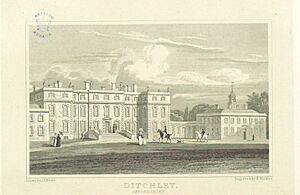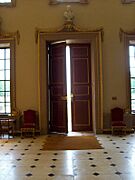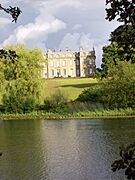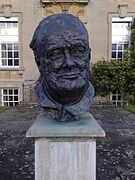Ditchley Park facts for kids
Quick facts for kids Ditchley Park |
|
|---|---|
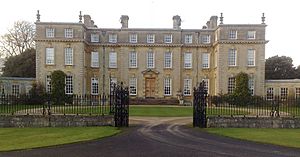 |
|
| Type | House |
| Location | Charlbury, Oxfordshire |
| Built | 1720 |
| Architect | James Gibbs exterior / William Kent, Henry Flitcroft interiors |
| Architectural style(s) | Palladian |
| Governing body | Ditchley Foundation |
|
Listed Building – Grade I
|
|
| Official name: Ditchley House Including flanking pavilions | |
| Designated | 27 August 1957 |
| Reference no. | 1251422 |
|
Listed Building – Grade II*
|
|
| Official name: Rotunda 600M NW of Ditchley House | |
| Designated | 27 August 1957 |
| Reference no. | 1251530 |
|
Listed Building – Grade II
|
|
| Official name: Entrance Screen, gates and balustrading to forecourt of Ditchley House | |
| Designated | 30 August 1988 |
| Reference no. | 1262725 |
|
Listed Building – Grade II
|
|
| Official name: Steps and flanking statuary 20M NW of Ditchley House | |
| Designated | 30 August 1988 |
| Reference no. | 1262763 |
| Official name: Ditchley Park | |
| Designated | 1 June 1984 |
| Reference no. | 1000463 |
| Lua error in Module:Location_map at line 420: attempt to index field 'wikibase' (a nil value). | |
Ditchley Park is a beautiful old country house located near Charlbury in Oxfordshire, England. This special place has a long history. It was once home to a Roman villa, then a royal hunting ground. Later, it belonged to important families like the Lees.
The house you see today was built in 1722. It was designed by a famous architect named James Gibbs. During World War II, Winston Churchill, who was the Prime Minister, used Ditchley Park as a safe place to stay on weekends. This was because his other homes were not as secure from enemy attacks. Today, Ditchley Park is owned by the Ditchley Foundation. This group works to improve relationships between different countries, especially between Britain and America.
Ditchley Park is a very important historic building. It is a Grade I listed building, which means it's one of the most important historic buildings in England. Its park is also listed as Grade II*.
Contents
History of Ditchley Park
Ditchley was once a small village in the Middle Ages. Records show it existed between the 14th and 17th centuries. However, there are no visible signs of this old village today. In the past, Ditchley was a place where people could stay while visiting the royal hunting grounds of Wychwood Forest.
The Lee Family and Royal Visits
During the Elizabethan era, the Lee family bought the Ditchley estate. Sir Henry Lee (1533-1611) was a well-known person at the royal court. He asked for a famous painting of Queen Elizabeth I to be made. This painting, called the Ditchley Portrait, shows the Queen standing on a map of the British Isles. One of her feet is placed near Ditchley, remembering her visit to Sir Henry Lee's home.
Sir Henry Lee was later known for politely refusing to host the Queen a second time. This was because her visits were incredibly expensive! King James VI and I and his wife Anne of Denmark also visited Ditchley on September 15, 1603.
The Tree Family's Influence
In 1933, Ronald Tree and his wife, Nancy Lancaster, bought Ditchley. Ronald was an American-born politician who became a Member of Parliament (MP) in Britain. Nancy was a very famous interior designer. She was known for having "the finest taste of almost anyone in the world." She worked with other designers to redecorate Ditchley Park, making it very beautiful.
Ronald and Nancy Tree were among the people who saw the danger of the Nazi party in Germany. They often invited Winston Churchill and his wife to dinner at Ditchley starting in 1937.
Winston Churchill's Secret Retreat
When World War II began, security experts worried about Churchill's safety. His private home, Chartwell, and his official country house, Chequers, were easy targets for German planes. Ditchley Park, however, was a perfect secret location. It had lots of trees and a hidden entrance road, making it hard to spot from the sky.
Churchill asked Ronald Tree if he could use Ditchley for "certain weekends, when the moon is high." Tree quickly agreed. Churchill first stayed at Ditchley on November 9, 1940. He brought his wife Clementine and daughter Mary. During his visits, Churchill held important meetings. He even discussed the Lend-Lease agreement with President Roosevelt's special advisor, Harry Hopkins. He also hosted the exiled Czechoslovakian President Edvard Beneš.
By late 1942, security at Chequers had improved. Churchill's last weekend stay at Ditchley as his official residence was on September 26, 1942. This was Ronald Tree's birthday. His very last visit was for lunch in 1943. In 1994, a bronze statue of Churchill was placed at Ditchley Park. This statue reminds everyone of the important role Ditchley played during World War II.
Ditchley Park Today
After the war, Ronald Tree sold Ditchley Park to Sir David Wills. Sir David was from the famous Wills tobacco family. In 1958, Sir David Wills created the Ditchley Foundation. This foundation works to improve international relationships, especially between Britain and America. The foundation still owns Ditchley Park today.
Ditchley Park has also been used for filming! Scenes from the final season of the popular TV show Downton Abbey were filmed there. Since 2002, it has also been home to the Butler Valet School.
Architecture and Special Designations
The current Ditchley Park house was built in 1722 for George Lee, 2nd Earl of Lichfield. The main architect was James Gibbs, and the builder was Francis Smith. Inside, the rooms were designed by William Kent and Henry Flitcroft. The beautiful fireplaces were made by Edward Stanton and his partner Christopher Horsnaile.
Ditchley Park is a Grade I listed building. This means it is considered a building of exceptional historical or architectural importance. Other important structures around the house are listed as Grade II. These include the entrance gates, steps, and statues. The park itself is listed as Grade II* on the Register of Historic Parks and Gardens of Special Historic Interest in England. This means it is a park of particular historic interest.
Archaeological Discoveries
On the Ditchley Park estate, there are remains of an old Roman villa. This villa is located at Watts Wells, less than a mile southeast of the house. It was a large house with columns, other buildings, and a granary for storing grain. The villa was surrounded by a rectangular ditch.
This Roman site was discovered from the air in 1934 and then dug up in 1935. It was first settled around AD 70 with wooden buildings. These were later replaced with stone buildings in the 2nd century. Around AD 200, a fire badly damaged the stone buildings, and the site was left empty. People returned to the site in the early 4th century and lived there until the end of that century.
Before the villa was found, a hidden collection of 1,176 bronze Roman coins was discovered nearby. These coins date from around AD 270 and seem to have been buried in a pot around AD 395. This was near the end of the Roman period in Britain. The coins are now kept at the Ashmolean Museum in Oxford.
Grim's Ditch, an ancient boundary, also runs through the Ditchley Park estate. It is believed to have been built during the Roman occupation of Britain around the 1st century AD. The name "Ditchley" actually comes from two Old English words. It means "the woodland clearing" ("-ley") located on Grim's Ditch.
Gallery


